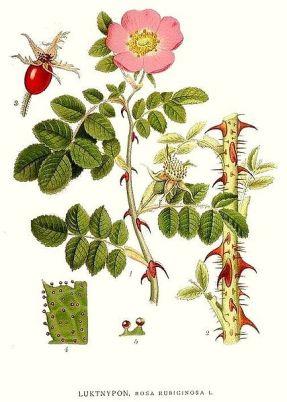Following on from my rosehip oil (RHO) review post, here I have a short article based on scientific research on the comparison between rosa canina (RC) and rosa eglanteria/mosqueta/rubiginosa (RR).

Rosa Canina

Rosa Rubiginosa
Most RHO brands out there uses RC. Below I have listed most known brands using RC or RR. These brands include those who have pure RHO (100% RHO) and RHO+ (plus other oils and ingredients) products.
Brands using Rosa Canina
Essano
CROP
Natio
Trilogy
Swisse
Rosehip Plus
MooGoo
Natural Instinct
People for Plants
A’kin
Modelco
In Essence
Oil Garden Aromatherapy
Brands using Rosa Rubiginosa
She
Sukin
Kosmea
Kora Organics
Thursday Plantation
In terms of pricing, usually RC is cheaper than RR. It is also much more common.
The reason why I started this mini research was the difference I felt when using Kosmea, which uses RR instead of RC. Upon googling the term ‘RC vs RR’, I stumbled upon these useful blog posts:
http://pixiedw.blogspot.com.au/2013/08/some-bits-and-pieces-of-rosehip-oil.html
http://www.thingsilove.com.au/2010/08/review-organic-rosehip-oil.html
I then proceeded to look for scientific research articles to back this hypothesis. Here are some that I have found to be informative. I have tried to find open access articles so everyone is able to read them too.
Note – Flavonoids are basically antioxidants. Here’s a longer, more scientific explanation: “They act in plants as antioxidants, antimicrobials, photoreceptors, visual attractors, feeding repellants, and for light screening. Many studies have suggested that flavonoids exhibit biological activities, including antiallergenic, antiviral, antiinflammatory, and vasodilating actions. However, most interest has been devoted to the antioxidant activity of flavonoids, which is due to their ability to reduce free radical formation and to scavenge free radicals.” (Pietta, 2000)
To sum the articles up, here’s the difference between RC and RR:
From Adamczak, Buchwald, Zielinski and Mielcarek, 2012:
Upon comparing 75 samples representing 11 species –
RC
Mean Vit C content – 0.51 g/100 g DM (dry matter)
Mean Citric acid content – 3.4 g/100 g DM (my reading of the graph)
Mean Flavonoid content – 41 mg/100 g DM
RR
Mean Vit C content – 1.18 g/100 g DM (my reading of the graph)
Mean Citric acid content – 3.1 g/100 g DM(my reading of the graph)
Mean Flavonoid content – 72 mg/100 g DM
“…flavonoids were highest in R. rubiginosa (72 mg/100 g DM)”
“…average flavonoid content in R. canina hips (41 mg/100 g DM) was nearly half that of R. rubiginosa hips (72 mg/100 g DM).”
“The average amount of vitamin C in R. canina hips (0.51 g/100 g DM) was nearly a third that of R. dumalis hips (1.44 g/100 g DM).”
“Rosa villosa is the richest source of vitamin C, while R. canina usually shows low content of it (Krzaczek et al., 1970; Gao et al., 2000); our results support that.”
From Roman, Stanila and Stanila, 2013:
“Yoo et al. reported a higher content in flavonoids (400 mg QE/100 g fresh fruit) but in Rosa rubiginosa, data which is in concordance with Adamczak et al. who obtained the highest concentration in flavonoids for Rosa rubiginosa among other 11 species of Rosa L.”
Concluding thoughts
Based on my quick research, it seems that RR’s content is more beneficial when compared to RC. This is purely comparing the concentration of the components (flavonoids, citric acid and vitamin C). As a consumer – I’m now more aware of what is in my RHO and of the options available in the market. I’m definitely trying Thursday Plantation and Sukin next, to see if the quality of their RHO is comparable to Kosmea.
After reading more blog posts, reviews and various articles on RHO (sorry can’t remember all the individual sources), I have also learnt that you should always buy unrefined, non-heat treated/cold-pressed RHO. You can see the difference in the colour. Heat treated RHO will be paler in colour and does not smell as strong. Kosmea’s RHO is reddish and smells quite strong, when compared to other RHO brands.
References
Pietta, P. G. (2000). Flavonoids as antioxidants. J Nat Prod, 63(7), 1035-1042.

